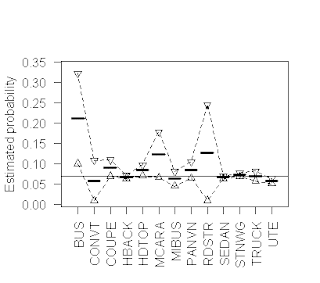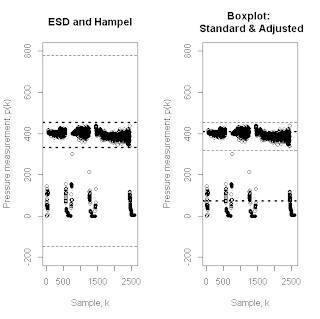It has been several months since my last post on
classification tree models, because two things have been
consuming all of my spare time. The
first is that I taught a night class for the University of Connecticut Tampere ,
Finland
Specifically, Professor Frank Harrell, the developer of the
extremely useful Hmisc package, asked the following:
How did you take into account model uncertainty? The uncertainty resulting from data mining to find nodes and thresholds for continuous predictors has a massive impact on confidence intervals for estimates from recursive partitioning.
The short answer is that model uncertainty was not accounted
for in the results I presented last time, primarily because – as Professor
Harrell’s comments indicate – this is a complicated issue for tree-based models. The primary objective of this post and the
next few is to discuss this issue.
So first, what exactly is model uncertainty? Any time we fit an empirical model to data,
the results we obtain inherit some of the uncertainty present in the data. For the specific example of linear regression
models, the magnitude of this uncertainty is partially characterized by the
standard errors included in the results returned by R’s summary() function. This magnitude depends on both the
uncertainty inherent in the data and the algorithm we use to fit the
model. Sometimes – and classification
tree models are a case in point – this uncertainty is not restricted to
variations in the values of a fixed set of parameters, but it can manifest
itself in substantial structural variations.
That is, if we fit classification tree models to two similar but not
identical datasets, the results may differ in the number of terminal nodes, the
depths of these terminal nodes, the variables that determine the path to each
one, and the values of these variables that determine the split at each intermediate
node. This is the issue Professor
Harrell raised in his comments, and the primary point of this post is to present
some simple examples to illustrate its nature and severity.
In addition, this post has two other objectives. The first is to make amends for a very bad
practice demonstrated in my last two posts.
Specifically, the classification tree models described there were fit to
a relatively large dataset and then evaluated with respect to that same dataset. This is bad practice because it can lead to
overfitting, a problem that I will discuss in detail in my next post. (For a simple example that illustrates this
problem, see the discussion in Section 1.5.3 of Exploring Data in Engineering, the Sciences, and Medicine.)
In the machine learning community, this issue is typically addressed by
splitting the original dataset randomly into three parts: a training subset
(Tr) used for model-fitting, a validation subset (V) used for intermediate
modeling decisions (e.g., which variables to include in the model), and a test
subset (Te) used for final model evaluation.
This approach is described in Section 7.2 of The Elements of Statistical Learning by Hastie, Tibshirani, and Friedman, who suggest 50%
training, 25% validation, and 25% test as a typical choice.
The other point of this post is to say something about the
different roles of model uncertainty and data uncertainty in the practice of
predictive modeling. I will say a little
more at the end, but whether we are considering business applications like
predicting customer behavior or industrial process control applications to
predict the influence of changes in control valve settings, the basic
predictive modeling process consists of three steps: build a prediction model;
fix (i.e., “finalize”) this model; and apply it to generate predictions from
data not seen in the model-building process.
In these applications, model uncertainty plays an important role in the
model development process, but once we have fixed the model, we have eliminated
this uncertainty by fiat. Uncertainty
remains an important issue in these applications, but the source of this
uncertainty is in the data from which the model generates its predictions and
not in the model itself once we have fixed it.
Conversely, as George Box famously said, “all models are wrong, but some
are useful,” and this point is crucial here: if the model uncertainty is great
enough, it may be difficult or impossible to select a fixed model that is good
enough to be useful in practice.
Returning to the topic of uncertainty in tree-based models, the
above plot is a graphical representation of a classification tree model
repeated from my previous two posts. This
model was fit using the ctree procedure in the R package party, taking all
optional parameters at their default values.
As before, the dataset used to generate this model was the Australian
vehicle insurance dataset car.csv, obtained from the website associated with
the book Generalized Linear Models for Insurance Data, by Piet
de Jong and Gillian Z. Heller. This
model – and all of the others considered in this post – was fit using the same
formula as before:
Fmla = clm
~ veh_value + veh_body + veh_age + gender + area + agecat
Each record in this dataset describes a single-vehicle,
single-driver insurance policy, and clm is a binary response variable taking
the value 1 if policy filed one or more claims during the observation period
and 0 otherwise. The other variables (on
the right side of “~”) represent covariates that are either numeric (veh_value,
the value of the vehicle) or categorical (all other variables, representing the
vehicle body type, its age, the gender of the driver, the region where the
vehicle is driven, and the driver’s age).
As I noted above, this model was fit to the entire dataset,
a practice that is to be discouraged since it does not leave independent
datasets of similar character for validation and testing. To address this problem, I randomly
partitioned the original dataset into a 50% training subset, a 25% validation
subset, and a 25% test subset as suggested by Hastie, Tibshirani and Friedman. The plot shown below represents the ctree
model we obtain using exactly the same fitting procedure as before, but applied
to the 50% random training subset instead of the complete dataset. Comparing these plots reveals substantial
differences in the overall structure of the trees we obtain, strictly as a function
of the data used to fit the models. In
particular, while the original model has seven terminal nodes (i.e., the tree
assigns every record to one of seven “leaves”), the model obtained from the
training data subset has only four.
Also, note that the branches in the original tree model are determined
by the three variables agecat, veh_body, and veh_value, while the branches in
the model built from the training subset are determined by the two variables
agecat and veh_value only.
These differences illustrate the point noted above about the
strong dependence of classification tree model structure on the data used in
model-building. One could object that
since the two datasets used here differ by a factor of two in size, the comparison
isn’t exactly “apples-to-apples.” To see
that this is not really the issue, consider the following two cases, based on
the idea of bootstrap resampling. I
won’t attempt a detailed discussion of the bootstrap approach here, but the
basic idea is to assess the effects of data variability on a computational
procedure by applying that procedure to multiple datasets, each obtained by
sampling with replacement from a single source dataset. (For a comprehensive discussion of the
bootstrap and some of its many applications, refer to the book Bootstrap Methods and their Application by A.C. Davison and D.V.
Hinkley.) The essential motivation is
that these datasets – called bootstrap resamples – all have the same essential
statistical character as the original dataset.
Thus, by comparing the results obtained from different bootstrap
resamples, we can assess the variability in results for which exact statistical
characterizations are either unknown or impractical to compute. Here, I use this idea to obtain datasets that
should address the “apples-to-apples” concern raised above. More specifically, I start with the training
data subset used to generate the model described in the previous figure, and I
use R’s built-in sample() function to sample the rows of this dataframe with
replacement. For an arbitrary dataframe
DF, the code to do this is simple:
> set.seed(iseed)
> BootstrapIndex = sample(seq(1,nrow(DF),1),size=nrow(DF),replace=TRUE
> ResampleFrame = DF[BootstrapIndex,]
The only variable in this procedure is the seed for the
random sampling function sample(), which I have denoted as iseed. The extremely complicated figure below shows
the ctree model obtained using the bootstrap resample generated from the
training subset with iseed = 5.
Comparing this model with the previous one – both built from
datasets of the same size, with the same general data characteristics – we see
that the differences are even more dramatic than those between the original
model (built from the complete dataset) and the second one (built from the
training subset). Specifically, while
the training subset model has four terminal nodes, determined by two variables,
the bootstrap subsample model uses all six of the variables included in the
model formula, yielding a tree with 16 terminal nodes. But wait – sampling with replacement
generates a significant number of duplicated records (for large datasets, each
bootstrap resample contains approximately 63.2% of the original data values,
meaning that the other 36.8% of the resample values must be duplicates). Could this be the reason the results are so
different? The following example shows
that this is not the issue.
This plot shows the ctree model obtained from another
bootstrap resample of the training data subset, obtained by specifying iseed =
6 instead of iseed = 5. This second
bootstrap resample tree is much simpler, with only 7 terminal nodes instead of
16, and the branches of the tree are based on only four of the prediction
variables instead of all six (specifically, neither gender nor veh_body appear
in this model). While I don’t include
all of the corresponding plots, I have also constructed and compared the ctree
models obtained from the bootstrap resamples generated for all iseed values
between 1 and 8, giving final models involving between four and six variables,
with between 7 and 16 terminal nodes. In
all cases, the datasets used in building these models were exactly the same
size and had the same statistical character.
The key point is that, as Professor Harrell noted in his comments, the
structural variability of these classification tree models across similar
datasets is substantial. In fact, this
variability of individual tree-based models was one of the key motivations for
developing the random forest method, which achieves substantially
reduced model uncertainty by averaging over many randomly generated trees. Unfortunately, the price we pay for this
improved model stability is a complete loss of interpretibility. That is, looking at any one of the plots
shown here, we can construct a simple description (e.g., node 12 in the above
figure represents older drivers – agecat > 4 – with less expensive cars, and
it has the lowest risk of any of the groups identified there). While we may obtain less variable predictions
by averaging over a large number of these trees, such simple intuitive
explanations of the resulting model are no longer possible.
I noted earlier that predictive modeling applications
typically involve a three-step strategy: fit the model, fix the model, and
apply the model. I also argued that once
we fix the model, we have eliminated model uncertainty when we apply it to new
data. Unfortunately, if the inherent model
uncertainty is large, as in the examples presented here, this greatly
complicates the “fix the model” step. That
is, if small variations in our training data subset can cause large changes in
the structure of our prediction model, it is likely that very different models
will exhibit similar performance when applied to our validation data
subset. How, then, do we choose? I will examine this issue further in my next
post when I discuss overfitting and the training/validation/test split in more
detail.









